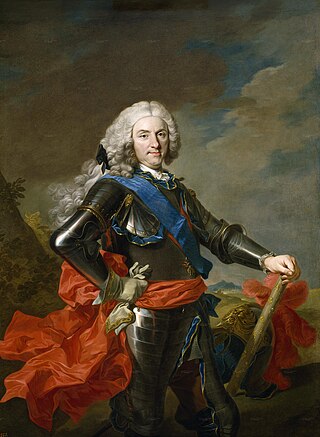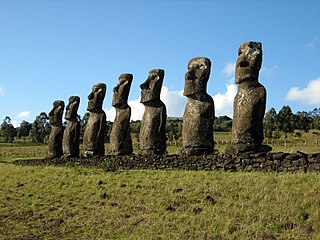
1743 (MDCCXLIII) was a common year starting on Tuesday of the Gregorian calendar and a common year starting on Saturday of the Julian calendar, the 1743rd year of the Common Era (CE) and Anno Domini (AD) designations, the 743rd year of the 2nd millennium, the 43rd year of the 18th century, and the 4th year of the 1740s decade. As of the start of 1743, the Gregorian calendar was 11 days ahead of the Julian calendar, which remained in localized use until 1923.
The 1730s decade ran from January 1, 1730, to December 31, 1739.
The 1720s decade ran from January 1, 1720, to December 31, 1729. In Europe it was a decade of comparative peace following a lengthy period of near continuous warfare with treaties ending the War of the Quadruple Alliance and the Great Northern War. Both Britain and France saw major financial crashes at the beginning of the decade with the South Sea Bubble and the Mississippi Company respectively. Nonetheless it was a decade of stability in both countries under the leadership of Robert Walpole and Cardinal Fleury and the two nations, recently enemies, formed the Anglo-French Alliance.

1728 (MDCCXXVIII) was a leap year starting on Thursday of the Gregorian calendar and a leap year starting on Monday of the Julian calendar, the 1728th year of the Common Era (CE) and Anno Domini (AD) designations, the 728th year of the 2nd millennium, the 28th year of the 18th century, and the 9th year of the 1720s decade. As of the start of 1728, the Gregorian calendar was 11 days ahead of the Julian calendar, which remained in localized use until 1923.

The 1620s decade ran from January 1, 1620, to December 31, 1629.
The 1600s was a decade of the Gregorian calendar that began on 1 January 1600, and ended on 31 December 1609.

1621 (MDCXXI) was a common year starting on Friday of the Gregorian calendar and a common year starting on Monday of the Julian calendar, the 1621st year of the Common Era (CE) and Anno Domini (AD) designations, the 621st year of the 2nd millennium, the 21st year of the 17th century, and the 2nd year of the 1620s decade. As of the start of 1621, the Gregorian calendar was 10 days ahead of the Julian calendar, which remained in localized use until 1923.

1758 (MDCCLVIII) was a common year starting on Sunday of the Gregorian calendar and a common year starting on Thursday of the Julian calendar, the 1758th year of the Common Era (CE) and Anno Domini (AD) designations, the 758th year of the 2nd millennium, the 58th year of the 18th century, and the 9th year of the 1750s decade. As of the start of 1758, the Gregorian calendar was 11 days ahead of the Julian calendar, which remained in localized use until 1923.

1585 (MDLXXXV) was a common year starting on Tuesday of the Gregorian calendar and a common year starting on Friday of the Julian calendar, the 1585th year of the Common Era (CE) and Anno Domini (AD) designations, the 585th year of the 2nd millennium, the 85th year of the 16th century, and the 6th year of the 1580s decade. As of the start of 1585, the Gregorian calendar was 10 days ahead of the Julian calendar, which remained in localized use until 1923.

1737 (MDCCXXXVII) was a common year starting on Tuesday of the Gregorian calendar and a common year starting on Saturday of the Julian calendar, the 1737th year of the Common Era (CE) and Anno Domini (AD) designations, the 737th year of the 2nd millennium, the 37th year of the 18th century, and the 8th year of the 1730s decade. As of the start of 1737, the Gregorian calendar was 11 days ahead of the Julian calendar, which remained in localized use until 1923.

1733 (MDCCXXXIII) was a common year starting on Thursday of the Gregorian calendar and a common year starting on Monday of the Julian calendar, the 1733rd year of the Common Era (CE) and Anno Domini (AD) designations, the 733rd year of the 2nd millennium, the 33rd year of the 18th century, and the 4th year of the 1730s decade. As of the start of 1733, the Gregorian calendar was 11 days ahead of the Julian calendar, which remained in localized use until 1923.

1729 (MDCCXXIX) was a common year starting on Saturday of the Gregorian calendar and a common year starting on Wednesday of the Julian calendar, the 1729th year of the Common Era (CE) and Anno Domini (AD) designations, the 729th year of the 2nd millennium, the 29th year of the 18th century, and the 10th and last year of the 1720s decade. As of the start of 1729, the Gregorian calendar was 11 days ahead of the Julian calendar, which remained in localized use until 1923.

1726 (MDCCXXVI) was a common year starting on Tuesday of the Gregorian calendar and a common year starting on Saturday of the Julian calendar, the 1726th year of the Common Era (CE) and Anno Domini (AD) designations, the 726th year of the 2nd millennium, the 26th year of the 18th century, and the 7th year of the 1720s decade. As of the start of 1726, the Gregorian calendar was 11 days ahead of the Julian calendar, which remained in localized use until 1923.

1724 (MDCCXXIV) was a leap year starting on Saturday of the Gregorian calendar and a leap year starting on Wednesday of the Julian calendar, the 1724th year of the Common Era (CE) and Anno Domini (AD) designations, the 724th year of the 2nd millennium, the 24th year of the 18th century, and the 5th year of the 1720s decade. As of the start of 1724, the Gregorian calendar was 11 days ahead of the Julian calendar, which remained in localized use until 1923.

1722 (MDCCXXII) was a common year starting on Thursday of the Gregorian calendar and a common year starting on Monday of the Julian calendar, the 1722nd year of the Common Era (CE) and Anno Domini (AD) designations, the 722nd year of the 2nd millennium, the 22nd year of the 18th century, and the 3rd year of the 1720s decade. As of the start of 1722, the Gregorian calendar was 11 days ahead of the Julian calendar, which remained in localized use until 1923.
The 1590s decade ran from January 1, 1590, to December 31, 1599.

1591 (MDXCI) was a common year starting on Tuesday of the Gregorian calendar and a common year starting on Friday of the Julian calendar, the 1591st year of the Common Era (CE) and Anno Domini (AD) designations, the 591st year of the 2nd millennium, the 91st year of the 16th century, and the 2nd year of the 1590s decade. As of the start of 1591, the Gregorian calendar was 10 days ahead of the Julian calendar, which remained in localized use until 1923.

1590 (MDXC) was a common year starting on Monday of the Gregorian calendar and a common year starting on Thursday of the Julian calendar, the 1590th year of the Common Era (CE) and Anno Domini (AD) designations, the 590th year of the 2nd millennium, the 90th year of the 16th century, and the 1st year of the 1590s decade. As of the start of 1590, the Gregorian calendar was 10 days ahead of the Julian calendar, which remained in localized use until 1923.

1578 (MDLXXVIII) was a common year starting on Wednesday in the Julian calendar.

1701 (MDCCI) was a common year starting on Saturday of the Gregorian calendar and a common year starting on Wednesday of the Julian calendar, the 1701st year of the Common Era (CE) and Anno Domini (AD) designations, the 701st year of the 2nd millennium, the 1st year of the 18th century, and the 2nd year of the 1700s decade. As of the start of 1701, the Gregorian calendar was 11 days ahead of the Julian calendar, which remained in localized use until 1923.


















